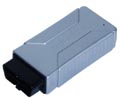- EDC-K E65 system
- |
- (EDC-K) Control system
- |
- BMW Electronic Systems
- |
- Technical Info
- |
- Car Tech Info
- |
- MicroTronik
Continuous Electronic Damper Control EDC-K E65

The EDC-K system records road surface, vehicle load and dynamic handling data. The control module adjusts the damping force of the shock absorbers according to those parameters. In contrast with the previous system, the damping force is infinitely variable. In addition, the driver has the option of selecting a comfort or sports setting. On the E65, the driver selects the desired setting by means of the Ergo-commander.
Control module
The functions of the control module are executed by microprocessors. The control module receives its power supply from electrical system of the vehicle (Terminal 30) via a load-relief relay with integral pole reversal protection. If the supply voltage falls below 9 Volts, the EDC system shuts down. The control module is located on the equipment sub-frame behind the glove compartment.
Acceleration sensors
The EDC system has three vertical acceleration sensors. They are located on the left and right front suspension strut upper mountings and the right rear suspension strut upper mounting. Those sensors measure the vertical acceleration of the vehicle body. The acceleration sensors run off a 5 Volt power supply.
Steering angle sensor
The information from the steering angle sensor is used to calculate the steering angle rate of change.
The steering angle sensor is on the steering column control center.
Infinitely variable shock absorbers
Twin-tube gas shock absorbers are fitted on the front and rear suspension.
The shock absorbers used with the EDC system are referred to as stored characteristic shock absorbers. They do not have fixed damping force settings as before.
There is a proportional control valve integrated in the piston of each shock absorber.
As the suspension travels up and down, gas flows back and forth through that valve.
A control valve induces a difference in pressure above and below the piston. That pressure difference alters the force acting on the piston rod.
The current to the control valves is limited to 2 A. In addition to the control valve there is also a base valve integrated in the shock absorber. Its job is to create a minimum pressure progression characteristic.
CAN interface
The steering angle is processed by the steering column control center (SZL) and placed on the CAN bus as a separate message.
The wheel speed signals for the two front wheels are passed to the CAN bus by the DSC control module. The EDC control module also receives analogue signals which are sent directly to it by the DSC control module.
Program selection
The driver has the option of selecting a comfort or sports program. The programs can be selected on the multifunction steering wheel or the Ergo-commander. The suspension is stiffer with the (Sports) setting and softer with the (Comfort) setting.
EDC-K system function
The EDC-K is a microprocessor-controlled variable shock absorber system. The EDC-K system consists of mechanical, hydraulic and electronic components. Sensors are used to detect handling dynamics, and road surface characteristics. In response to that measured data, the control module makes adjustments to the shock absorbers. In this way, body and wheel oscillation is suppressed as required by the particular circumstances. In addition, the driver can choose between a comfort and a sports program. Immediately after starting the engine, the EDC-K is always in Comfort mode. When the vehicle is stationary, the shock absorber valves are de-energized; they are energized at vehicle speeds upwards of approx. 5 km/h.
In the event of a fault, the system shuts itself down and the shock absorber valves are then de-energized.
When that happens, the suspension may feel very hard but the vehicle is nevertheless safe to drive. Valve, sensor, electrical circuit and control module faults are detectable as system faults. Once a fault has been detected, it remains registered for the rest of the journey. Detection of a sensor fault results in a fixed current being applied to the valve output stages (medium damping force) or the system shutting down completely (very high damping force).
In terms of function, the EDC-K can be divided into three blocks:
· Control module
· Sensors and program selection
· 4 electronically infinitely variable shock absorbers
Steering angle sensor offset
If the steering angle sensor has been removed and refitted, a steering angle offset must be carried out using AutoHex diagnostic scan tool.
This requires that the steering wheel is in the straight-ahead position.
is one of the best Professional scan tools to for BMW; Autohex allows you to diagnose, code, program/flash ecus, replace with used ECUs, and add new keys for BMW. For more information: BMW Scan Tool
GDS KIA Ecu Flashing using AutoHex II


